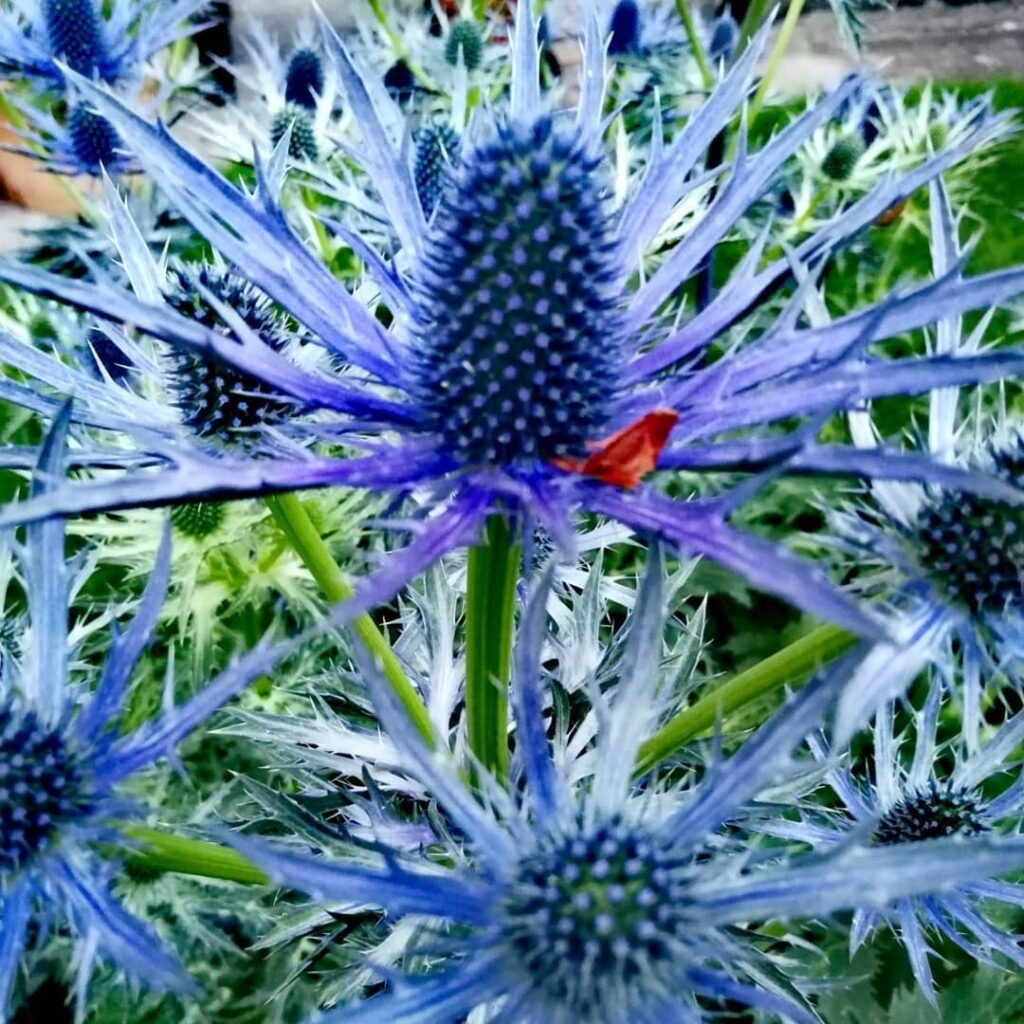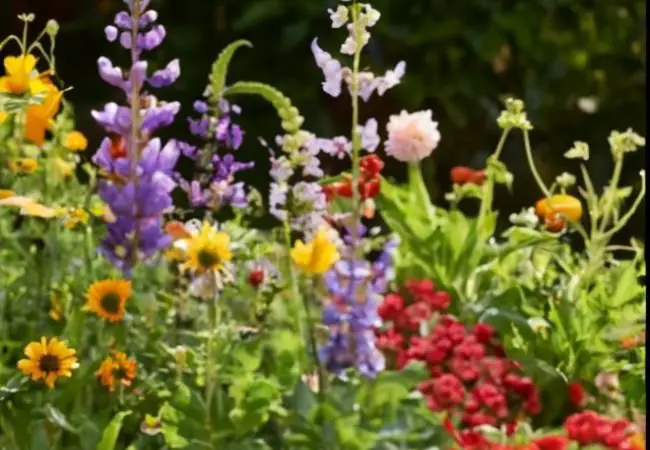Explore Blue Thistle—from growing tips and care to wedding uses and symbolism. A must-read for USA gardeners wanting unique, easy beauty in their yards.

Hey there, plant enthusiasts! I’m Ashley Scott, and with 10 years of gardening experience under my belt, I’ve grown a lot of beautiful plants. But there’s something extra special about Blue Thistle. Its striking metallic blooms, unique texture, and deep symbolism make it a standout whether you’re planting it in your garden or using it in a wedding. In this guide, I’ll walk you through everything I’ve learned about Blue Thistle—from how to grow it to its role in Blue Thistle bouquets and its hidden meanings. Let’s get started!
What Is Blue Thistle?

Blue Thistle, often called Eryngium or Sea Holly, isn’t a true thistle, despite its spiky, thistle-like look. It’s part of the Apiaceae family and is famous for its blue thistle flowers—gorgeous metallic blue or silver-blue blooms surrounded by prickly bracts. These give it a bold, dramatic vibe that’s hard to miss.
I first stumbled across Blue Thistle at a friend’s wedding, where it starred in a Blue Thistle bouquet. The color popped, the texture wowed, and I was hooked. Since then, I’ve been growing this beauty in my garden and sharing its magic with anyone who’ll listen.
Why Choose Blue Thistle for Your Garden?
So, why should you add the blue thistle plant to your yard? Here’s what makes it a gardener’s dream:
- Eye-Catching Looks: Those blue thistle flowers are a rare, metallic hue that adds color and texture like nothing else.
- Low Maintenance: Once it’s settled in, Blue Thistle handles drought and poor soil like a champ.
- Pollinator Magnet: Bees and butterflies flock to its nectar-rich blooms.
- Versatile: You can dry the flowers for crafts or arrangements—they last forever!
In my own garden, the blue thistle eryngium is a total showstopper. People always ask about it, and they’re shocked when I tell them how easy it is to grow.
How to Grow Blue Thistle
Growing Blue Thistle is simpler than you’d expect. Here’s my step-by-step guide based on a decade of trial and error:
1. Picking the Perfect Variety
There are tons of Eryngium types, but these are my go-tos for that iconic blue:
- Eryngium planum (Flat Sea Holly): Reaches about 3 feet with small, steel-blue blooms.
- Eryngium giganteum (Miss Willmott’s Ghost): Boasts big, silvery-blue bracts.
- Eryngium alpinum (Alpine Sea Holly): Deeply lobed leaves and vivid blue flowers.
I kicked things off with Eryngium planum because it’s tough and adapts to almost any climate.
2. Planting Blue Thistle
- Timing: Sow Blue Thistle seeds in early spring or fall. For nursery plants, spring works best.
- Soil: It loves well-draining, sandy soil. Skip the heavy clay—it won’t thrive there.
- Sunlight: Full sun is non-negotiable. My plants with 6+ hours of sun have the brightest blue thistle flowers.
- Spacing: Give them 18-24 inches of room to spread out.
Pro Tip: Starting from Blue Thistle seeds? Pop them in the fridge for a few weeks first to stratify them. It tricks them into thinking they’ve had a winter, boosting germination.
3. Caring for Blue Thistle
- Watering: Keep young plants hydrated until they’re established. Mature ones only need water during long dry spells.
- Fertilizing: No fuss here—a little compost in spring does the trick.
- Pruning: Snip off faded flowers to keep the blooms coming. In fall, cut it back to the ground for winter.
I’ve seen Blue Thistle tough out scorching summers with barely any help from me. It’s a survivor!
Blue Thistle in Weddings: A Unique Twist
The blue thistle plant isn’t just for gardens—it’s a wedding favorite, too. Think Blue Thistle bouquets and Blue Thistle boutonnieres that steal the show with their bold style.
Why It’s a Wedding Win
- Blue Thistle Meaning: It symbolizes protection and courage—perfect for a big day.
- Toughness: These blooms stay fresh out of water, ideal for all-day events.
- Color Pop: That blue ties into so many wedding themes, from rustic to chic.
I once helped a friend weave Blue Thistle into her wedding flowers, mixing it with white roses and greenery. The contrast was stunning, and it felt extra special knowing it came from her garden. Want more ideas? Check out this Guide to Blue Thistle Wedding Flowers.
The Symbolism of Blue Thistle
Blue Thistle isn’t just pretty—it’s packed with meaning. Here’s what it stands for across cultures:
- Protection: Those spikes? They’re said to keep bad vibes away.
- Resilience: Thriving in tough spots, it’s a symbol of independence.
- Honor: In Scotland, the thistle’s a national icon of nobility and bravery.
To me, Blue Thistle meaning is all about strength through challenges. It’s a little reminder from my garden that beauty can bloom anywhere.
Where to Buy Blue Thistle
Ready to get your hands on some? Here’s where I shop:
- Local Nurseries: Look for Eryngium in the perennial aisle.
- Online Stores: Annie’s Annuals and High Country Gardens have great Blue Thistle plants and seeds.
- Seed Catalogs: Baker Creek Heirloom Seeds and Swallowtail Garden Seeds are my go-tos for Blue Thistle seeds.
I usually grab seeds online and start them indoors—it’s cheap and lets me grow a bunch at once.
Common Questions About Blue Thistle
Got questions? Here are some I hear all the time, answered from my experience:
Is Blue Thistle a Perennial?
Yep! Most Blue Thistle varieties are perennials, coming back every year. Some, like Eryngium giganteum, are biennials—blooming in year two, then done.
How Do I Dry Blue Thistle Flowers?
Cut the stems when the blue thistle flowers are fully open, then hang them upside down in a dark, dry spot for two weeks. They keep that gorgeous color perfectly.
Can Blue Thistle Grow in Pots?
Totally! It works in containers with good drainage. Use sandy soil and stick it in full sun.
Is Blue Thistle Invasive?
Nope, it’s not a troublemaker. It self-seeds a bit, but deadheading keeps it in check.
For more gardening know-how, peek at my Perennial Gardening post on my site!
My Personal Blue Thistle Story
I’ll never forget my first Blue Thistle bloom. It was a blazing summer day, and those metallic flowers practically glowed. The bees and butterflies swarmed it, turning my garden into a buzzing paradise.
One year, I paired it with lavender and echinacea. The mix of blue, purple, and pink was pure magic—a living rainbow that lasted all season. It’s hands-down one of my favorite gardening experiments.
If you want a plant that’s stunning, meaningful, and easy, Blue Thistle is it. It’s a pollinator party, a conversation piece, and a tough cookie all in one.
Conclusion: Fall in Love with Blue Thistle
Blue Thistle is more than a plant—it’s a vibe. Whether you’re growing the blue globe thistle plant for its knockout blooms, crafting a Blue Thistle boutonniere, or just soaking in its symbolism, it’s a winner. Low effort, high reward—what’s not to love?
I hope this guide gets you excited to try Blue Thistle yourself. Got questions or stories? Drop them in the comments—I’d love to chat! Happy planting!
For more tips, swing by USA Garden Hub.






